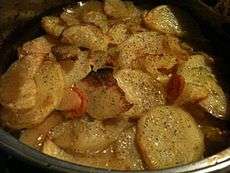Lancashire hotpot
|
Lancashire hotpot | |
| Course | Main course |
|---|---|
| Place of origin | Lancashire, England |
| Serving temperature | Hot |
| Main ingredients | lamb or mutton, onions, potatoes |
|
| |
Lancashire hotpot is a stew originating from Lancashire in the North West of England. It consists of lamb or mutton and onion, topped with sliced potatoes and baked in a heavy pot on a low heat.[1]
History
In Lancashire before industrialisation, families would work at home spinning thread while scrags of mutton stewed slowly over a low fire. Family members could attend to the cooking over many hours. In the initial stages of industrialisation and urbanisation, both men and women of all ages had long strictly regulated work hours that made it impossible to cook food that required extensive attention and preparation time. Often lacking their own cooking facilities, housewives would carry a pudding or stew to the baker's oven and leave it there to cook.[2][3]
Preparation
The standard recipe calls for a mix of mutton (nowadays more frequently lamb) and onions covered with sliced potato. Many regional variations add vegetables (carrot, turnip, or leeks). Many early recipes add lamb kidneys and modern variants may use beef or bacon chops instead of lamb, or have a pastry topping.[4]
The traditional recipe once included oysters,[1] but increasing cost eliminated them from common usage. Pickled red cabbage or beetroot, and in some areas Lancashire cheese. are often served as an accompaniment.[5]
Etymology
It is often thought that the "hot pot" referred to is a pottery dish used to cook casseroles in British cuisine. However, it is more likely to refer to the idea of a jumble or hodge podge of ingredients in the filling.[6][7] Sir Kenelm Digby's 1677 The Closet Opened contains a recipe for the "Queen Mothers Hotchpot of Mutton".[8] Similarly, Mrs Beeton's Cookery Book contains a recipe for "Hotch Potch", calling for neck of mutton, onion, carrot, peas, cauliflower, and lettuce.[9]
See also
References
- 1 2 Alan Davidson (21 August 2014). The Oxford Companion to Food. OUP Oxford. pp. 400–. ISBN 978-0-19-104072-6.
- ↑ Andrea Broomfield (2007). Food and Cooking in Victorian England: A History. Greenwood Publishing Group. pp. 16–. ISBN 978-0-275-98708-4.
- ↑ Tom Holman (14 October 2010). A Lancashire Miscellany. Frances Lincoln. pp. 7–. ISBN 978-1-907666-41-4.
- ↑ Cloake, Felicity (31 October 2013). "How to cook the perfect Lancashire hotpot". The Guardian. Retrieved 9 September 2016.
- ↑ Michelin Travel & Lifestyle (1 March 2012). Michelin Green Guide Great Britain. Michelin Travel & Lifestyle. pp. 416–. ISBN 978-2-06-718232-5.
- ↑ A Hodge Podge of Hot-pots, 31 May 2007.
- ↑ Cloake, Felicity (31 October 2013). "How to cook the perfect Lancashire hotpot". The Guardian. Retrieved 9 September 2016.
- ↑ Sir Kenelm Digby (1677) The Closet Opened. H. Brome. Pages 144–145
- ↑ Mrs Beeton's Cookery Book (New ed.). Ward, Lock. 1930. pp. 84–85.
